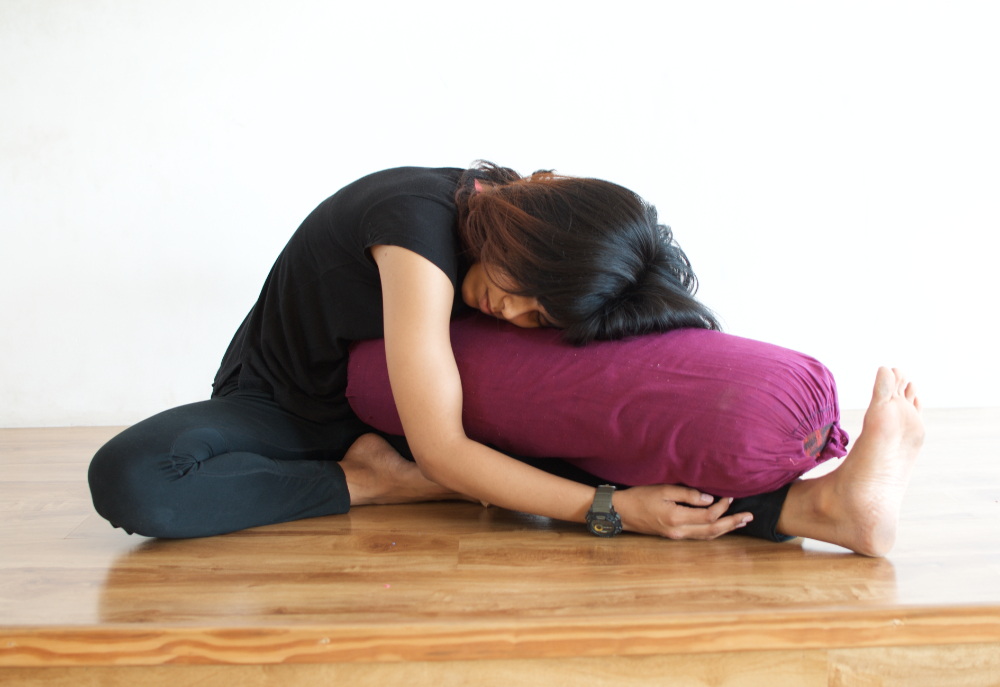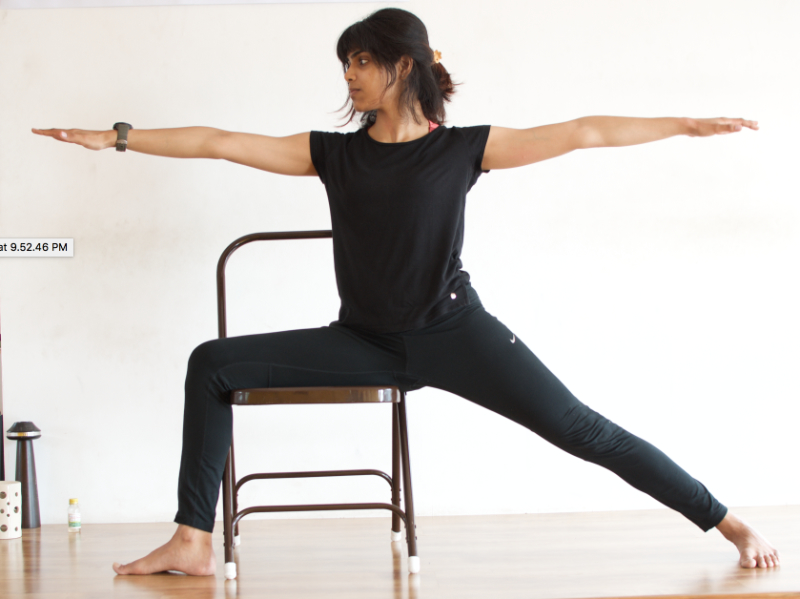Yoga Therapy
In view of the COVID-19 situation, all in-person classes are suspended. I will be taking a limited number of online clients. Drop me a message if you would like to schedule an online session.
You can also leave a WhatsApp message on +91 9082304707 or mail healwithramya[at]gmail[dot]com.
What is Yoga Therapy?
Yoga therapy is the therapeutic application of yogic practices and tools towards achieving a specific mental, physical, emotional, or spiritual goal or wellness objective.
The tools and practices used broadly include asanas, breathwork, meditation, and chanting, alone or in some combination. A lesser known aspect of yoga therapy is also the application of yogic philosophy to aspects of life that might be causing issues. It is surprising how many troubles are resolved with awareness, kindness, and compassion. Yoga has a set of yamas and niyamas, ethical guidelines to living, a code of conduct for living a peaceful life.
The yamas, for instance, are ahimsa (non-violence), satya (truth), asteya (non-stealing), brahmacharya (traditionally translated as celibacy, but can be taken as using your energy in the right way), aparigrapha (non-hoarding). If you give it a thought, it is fairly obvious how incorporating the five yamas into your life even to a small extent can lead to simpler and calmer state of being.
What Does Yoga Therapy Look Like?
The yoga therapist and the client have an initial intake and assessment session for the therapist to get an idea of what brings the client to yoga therapy and what he/she wants. They then decide, together, therapeutic goals for the clients. Maybe the goal is to reduce stress. Maybe it is to learn to live with chronic pain better. Maybe it is to improve sleep. Maybe it is to ameliorate symptoms of IBS.
The yoga therapist then formulates an outline for the work they will do together over the next few weeks as required. Each session will involve yoga, discussion, and a simple series of practices to be taken home and practiced by the client. This helps establish a regular and healthy routine by starting small and building up as the therapy sessions go by. It also helps empower the client; one of the goals of yoga therapy is to bring the client to a place where they don’t need a yoga therapist anymore.
Depression, Anxiety, other Mental Health Conditions

A good fraction of research studies that are being done on yoga for wellness are related to mental health. So much so that one complete issue (Vol 55, Issue 7) of the Indian Journal of Psychiatry was dedicated to research about yoga and mental health. There is also a yoga centre as a part of NIMHANS, one of the most prominent institutions for mental heath and neuroscience in India.
Mental illness is something that is only now coming out into the open in our country. We are trying to eliminate stigma and provide better and more accessible treatment options. But we aren’t quite at the stage where we look at preventive mental health care as much as we should.
Yoga believes that each person is whole and complete, and that healing comes from within. That you might be suffering, but you aren’t broken. And so the approach is to find what wellness is for each individual, rather than trying to ‘treat’ a specific illness. That said, there is research supporting yoga’s therapeutic effects for depression, anxiety, insomnia, and the social and cognitive deficits that often accompany schizophrenia.
Medicines used to treat mental health conditions usually also come along with a whole bunch of unpleasant side-effects. But it is a risk-benefit balance that psychiatrists and their clients have no choice but to walk. Yoga helps with these; weight control, prevention of diabetes, improved concentration and balancing energy levels are quite accessible with regular and directed practice.
Click here for more.
Crohn’s, Colitis, Irritable Bowel Syndrome (IBS)
As someone who has had Crohn’s, I can only too well understand how tough chronic digestive conditions can be. Pain, cramps, nausea, heartburn, acidity, medication, puking, pooping, running to find a bathroom, and in a lot of cases, surgery. It is an illness that is to be managed and is rarely ‘cured’. IBS can also present with constipation.
I was talking to my doctor recently, and he said, “Well, we can hope it never comes back, but there’s not much we can do, it’s a chronic condition.”
After a pause, he said, “Meditation has been shown to help. You should try.”
Yes! It has! And not just meditation. Yoga has practices that can cool the body, ease stress (a well-known and major trigger for Crohn’s and other bowel disorders), improve functioning and digestion, relieve constipation, help tolerate pain (see next section), and increase mental and physical strength and health, the list is endless.
What would yoga sessions for these individuals look like? It varies. Someone in an acute disease flare-up would require rest and perhaps some meditation and visualisation. In a more long-term situation, the sessions would involve practices to calm the mind, to get the body moving and functioning well metabolically, to help balance the immune system (immunosuppressants, I’m looking at you), and to learn tools to live a full and happy life with a potentially reduced risk of flare-ups.
Pain Management
Do parts of your body hurt? Really hurt? Does your entire body hurt? Have you been told nothing can be done about it or that you’ll have to wait it out? And does it hurt too much in the meantime?
Recent research is showing that there are no pain receptors in the nerves. That means your body is taking a bunch of sensations and your mind is converting it into pain. That does not mean the pain it not real, it means your pain can be managed to reduced by bringing your brain to a calmer state. Pain was evolutionarily meant to be a danger alarm. By telling your central nervous system it is okay, know that all pain can get better, if not go away completely.
Pain is multi-dimensional. Often pain that manifests in one part of the body is really a signal from some other part of the body or psyche. Long-term pain might be stress held in your body. Nerve-related pain like CRPS (Complex Regional Pain Syndrome) and fibromyalgia are thought to be exacerbated by stress and excessive sympathetic arousal of the nervous system, the evolutionary flight or fight response.
Now how can yoga help with pain, especially with chronic pain? This central nervous system hyperarousal leads to issues with muscle tension, irregular breathing patterns, energy, fatigue, sleep, and mindset.

Yoga works across the physical, physiological, mental, emotional, and energetic aspects of your body to start the process of relaxing the muscles, of slowing the breath down, and of creating a sense of stability. And the body relaxes and the breath slows down, the mind relaxes, telling your nervous system that it is okay and to calm down.
Practices often used to help with pain include asanas to work with physical symptoms, improve balance and circulation, strengthen and relax muscles, pranayama to induce mind-body relaxation and develop greater awareness of the breath, and meditation and visualisation to achieve a sense of wellbeing. Yoga helps you heal your pain from inside out.
Diabetes, Hypertension, PCOD
Diabetes, hypertension, and PCOD are very different disorders. I’m only bundling them together here because of the sizeable impact lifestyle and physical health have on all of them. Also because individual sections for all the various things yoga can help with (everything, basically) would make this page very very long. Yoga in this instance would broadly be practices to help reduce stress, improve physical health, reduce weight if medically required, relax, improve circulation, etc. all of which would improve the hormonal response of the body. The sessions would then be individually tailored based on the needs and symptoms of each client.
In people with PCOD, yoga also often helps manage pain, balance weight, mood swings, and maintain optimal health. Improving circulation, reducing heartrate, and calming the nervous system down are great for working with hypertension.There are also studies that have been carried out which indicate potential improvement in nerve conductivity in mild to moderate type-2 diabetes, which could help prevent or ameliorate mild neuropathy. In all cases, a trained yoga therapist would ensure that practices that could be detrimental are excluded completely.
Neurological Disorders
Yoga is now being used to a good extent in orthopedic and mental heath disorders and clinics, but its use in individuals affected with chronic neurological disorders is still limited.
These disorders could include epilepsy, dementia, stroke, Parkinson’s, multiple sclerosis, symptoms caused by traumatic brain injuries, etc. There are millions of people in the country who have a neurological condition that changes how they live their life — socially, emotionally, financially, sometimes with reduced autonomy, mobility, or cognitive ability. It can be scary.

Healthcare professionals are now largely in unison about the importance of exercise and relaxation in maintaining health and improving quality of life in those with neurological or neuromuscular disorders. They can also potentially delay the course of degenerative and progressive disorders. Yoga, then, can be a great adjuvant therapy to try in addition to regular treatment.
So what would yoga for neurological wellness look like? While each individual is unique and therefore warrants a treatment plan that is just as unique, there is no doubt that yoga can help. It can be used to improve range of motion, mobility, strength, balance and calmness. It can also increase resilience to stress, one of the most controllable factors that exacerbates neurological disorders or flare-ups. It can calm the body down. It can aid in fall prevention in those with impaired balance. It can also improve memory, focus, and mood.
Disorders such as multiple sclerosis and epilepsy, with their unpredictability, can also lead to anxiety and fear. Yoga has several grounding mind-body practices that are very helpful at a time when life might seem difficult, confusing, and complicated.
Yoga Therapy as Your Path to Optimal Health
If I were to enter a room and ask how many people would like to improve their quality of life, most hands would go up. We live in an age where we are stressed and running and trying to figure out who we are and what we want from life. In such a time, it becomes extremely important to take a step back every now and then and see whether you are alright. Are you thriving or are you only getting by?
Life comes with plenty of ups and downs but if you find that you are at a suboptimal state of physical, mental, emotional, or spiritual wellbeing most of the time, yoga can help. Our goal would be to figure out where you are, where you would like to be, and how to bridge that gap using various yogic tools.
You deserve to thrive.


